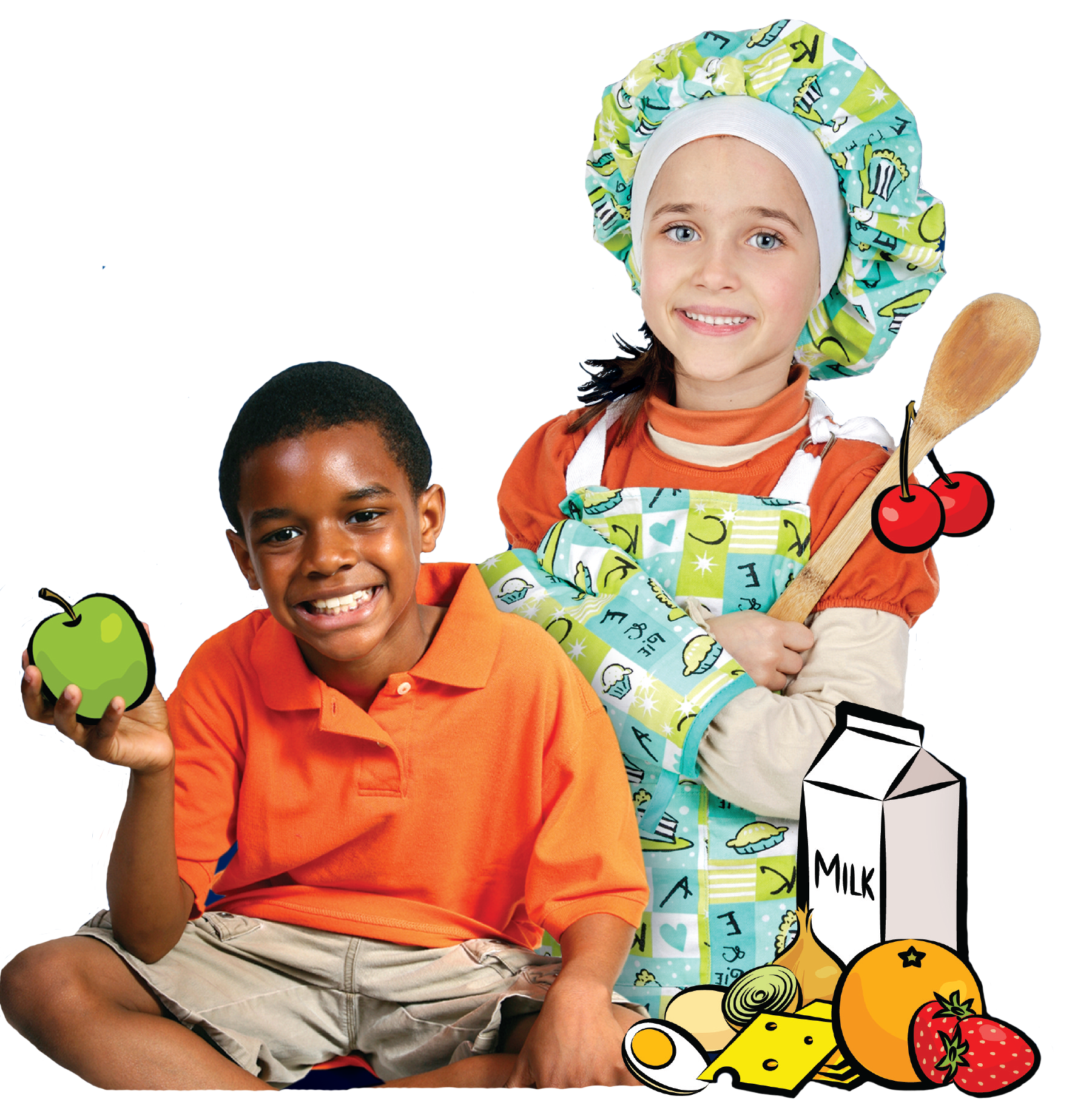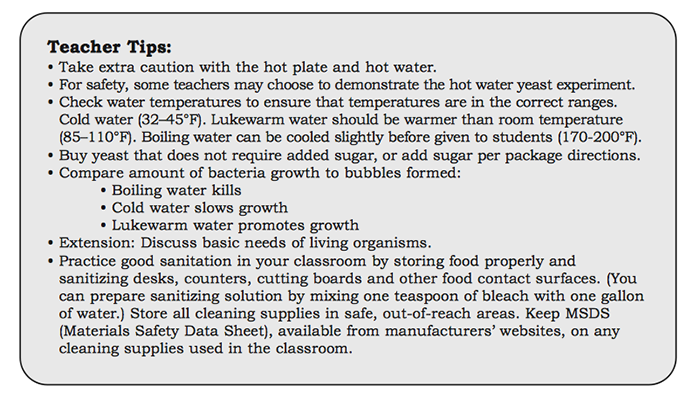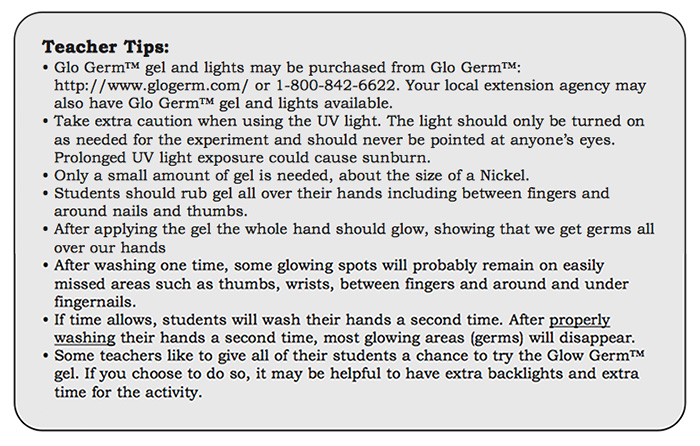Lesson Plan
FoodMASTER: Food Safety
Grade Level
Purpose
Students measure the temperature of cold, lukewarm, and hot water using a thermometer, investigate the growth of microorganisms by observing yeast growth at varying temperatures, and practice proper techniques for hand washing. The use of Glo Germ (TM) gel visually reinforces the importance of personal hygiene/hand washing. Grades 3-5
Estimated Time
Materials Needed
Activity 1: Temperature and Microorganisms
- For the teacher: Permanent marker, hot plate, small pot with lid, water, bimetallic stemmed thermometer, 1 foam cup filled with water (or clear cup or jar).
- For each group: 1 liquid measuring cup, 3 small foam cups, 1 bimetallic stemmed thermometer, 3 packets active dry yeast, water (cold, lukewarm, boiling). Optional: 1 ice cube.
- Safe Kitchen Cooks student handout
- Scientific Inquiry: Temperature and Microorganisms student handout
- Kitchen Clean Up student handout
- Teacher Answer Keys
Activity 2: Healthy Hands
- For the teacher: Glo Germ™ gel, UV light.
- For each group: 1 piece of paper, pencil, sink, soap, paper towels, 1 yellow marker, 1 red marker. Optional: 1 green marker.
- Healthy Hands student handout
- Hand Washing student handout
- Teacher Answer Keys
Elaborate
Vocabulary
bacteria: a group of single-celled living things that cannot be seen without a microscope that reproduce rapidly and sometimes cause diseases
food safety: the practice of handling, preparing, and storing food in a way that prevents food-borne illness
foodborne illness: any illness resulting from the consumption of food contaminated with viruses, parasites, or pathogenic bacteria
temperature danger zone: between 41 degrees Fahrenheit and 135 degrees Fahrenheit
Background Agricultural Connections
Introduction to FoodMASTER:
FoodMASTER (Food, Mathematics and Science Teaching Enhancement Resource) is a compilation of programs aimed at using food as a tool to teach mathematics and science. It is our theory that if food is used as a tool to teach mathematics and science, students will be better prepared to demonstrate and apply mathematic and scientific knowledge. Because students encounter food on a daily basis, they have preexisting contextual experiences preparing them for learning new and relevant mathematics and science material.
Food is conducive to hands-on and virtual, inquiry-based, active learning that uses multiple senses to engage students in the learning process. Utilizing food allows for an interdisciplinary approach to learning concepts and ideas in a variety of scientific subjects like general science, biology, chemistry, microbiology, nutrition and health. Additionally, food labs are a dynamic way to teach mathematics concepts such as numbers and operations, algebra, geometry, measurement and problem solving.
The knowledge and skill development that can be inspired by the FoodMASTER approach is limitless. Proper use of measurement tools, data collection and interpretation, application and generalization, classification and organization, graphing and comparative analysis, understanding chemical changes, observing functions of ingredients and controlling variables, pricing, critical thinking, self-directing learning, and team building are only a few of the potential knowledge and skill development areas for intermediate grade students experiencing FoodMASTER’s scientific inquiry labs.
Additional FoodMASTER lessons can be found to cover health and nutrition topics such as:
- Food Safety
- Vegetables
- Fruits
- Meat, Poultry, and Fish
- Eggs
- Fats and Oils
- Grains
- Measurement
- Meal Management
Background for this Lesson:
Food safety is handling, storing and preparing food in ways to keep food safe. Poor food safety can make people sick. Any illness caused by food is called foodborne illness. As safety experts, your students can keep their friends, family and themselves safe by practicing good food safety and sanitation and telling others about food safety.
In this lesson students will:
- use a kitchen thermometer to measure temperature;
- state temperatures that slow yeast growth and temperatures that kill yeast;
- make reasonable conclusions about temperatures in which microorganisms grow best;
- select food storage locations in which microorganisms grow best;
- state how long hands need to be washed;
- demonstrate proper hand-washing techniques; and
- communicate the importance of hand washing.
Engage
Students will be learning how to keep food safe from foodborne illnesses.
- To introduce the lesson, begin by drawing on your student's prior knowledge. Ask them, "What have your parents taught you to do at home in order to keep your food from spoiling or making you sick?" If necessary, use more guiding questions for students to identify that they keep some food in the refrigerator, they put groceries in the fridge/freezer as soon as they get home from the store, they cook foods thoroughly, etc.
- Next, establish with your students that most foods they eat on a daily basis are grown or raised on a farm. Tell your students that you are going to call out a food item. After you call out the food, they are to respond by echoing back to you the name of the animal that produces that food. For example, the teacher calls out, "Milk" and the students will respond by saying, "Cow." Repeat this process for several food items such as:
- Hamburger (Cattle)
- Bacon (Pigs)
- Eggs (Chickens)
- Yogurt (Cows)
- Chicken (Chicken nuggets or chicken fingers)
- Cheese (Cows)
- Sausage (Pigs)
- Draw a flow diagram on the board showing the "Farm to Fork" path of the majority of our food. Teach students that keeping our food safe begins on the farm. Give a brief description of each step along the way and some things that help ensure our food is safe and healthy to eat.

- Farm: Farmers take good care of their animals and crops. They follow guidelines and practices to produce food that is healthy and safe. Dairy farmers cool their milk immediately and store it in a refrigerated tank to minimize the growth of bacteria that could make us sick. Farmers also work hard to keep their farm and equipment clean and sanitized to stop the spread of harmful bacteria.
- Processing Plant: The processing plant is where a raw food product is prepared for retail sale. For example, milk is pasteurized, homogenized and processed into butter, cheese, ice cream or other dairy products at a processing plant. Meat can be cut and packaged at a processing plant or made into hamburger, sausage or sandwich meat. Processing plants have strict guidelines for sanitation and cleanliness to keep our food safe. Workers wear hair nets and clean, protective clothing.
- Grocery Store: Most consumers purchase their food from a retail grocery store. Grocery stores ensure that food is kept at the proper temperature and that it is not kept on the shelf too long.
- Your Home: Today, students will be learning what they can do at home to help keep their food safe and healthy.
Explore and Explain
Activity 1: Scientific Inquiry: Temperature and Microorganisms
- Ahead of time, label three cups per group “C,” “W” and “H” (C = cold, W = lukewarm, H = hot).
- Fifteen minutes prior to the activity, begin heating about two cups of water in a small pot on the hot plate. Bring to a light boil.
- Read Safe Kitchen Cooks and complete the Doodle Bugs.
- Demonstrate how to use the thermometer. First, point out the sensing area on the thermometer from the tip to the dimple. Then place the stem of the thermometer into the cup of water. Remind students that the whole sensing area must be underwater and that the stem should not touch the bottom or sides of the container. Next, watch as the needle moves and then comes to a stop. Explain the meanings of the markings on the thermometer and read the temperature.
- Divide the class into groups of four.
- Students will complete Scientific Inquiry: Temperature and Growth. For safety, let the boiling water cool slightly (170-210° F). Cold and lukewarm water may come from the tap. Add an ice cube to the cold water to ensure that it is cold enough.
- While the yeast is growing, students may complete While You Wait: Kitchen Clean Up.
- Students will make observations, complete the chart, discuss results and answer questions.

Class Discussion:
- What do you need to live and grow? (Water, food, oxygen and a constant body temperature).
- Do you need water to live? (You can only live a few days without water. In the dessert, you can only live one day without water. Could you live in super cold temperatures? Could you live in super hot temperatures like on the sun? Could you live in the ocean without air? Could you live without food?
- What did the yeast need to grow? (Time, right temperature, food (sugar), oxygen, moisture/water).
- At what temperature did the yeast grow best?
- Do other microorganisms grow at the same temperatures as yeast grows?
- What locations/temperatures are best for storing food?
While you Wait:
While the yeast is growing, students will complete While you Wait: Kitchen Clean Up. They will identify poor food safety practices and draw a super safe kitchen. Provide colored pencils for each student.

Activity 2: Healthy Hands
- Read Healthy Hands and complete the Doodle Bugs.
- Divide the class into groups of four to complete Scientific Inquiry: Hand Washing. Each group will need a reader, recorder, washer and prop person.
- Prop people will gather supplies.
- Readers will reread the hand washing steps.
- Recorders will trace an outline of a hand on a piece of paper.
- An adult will squeeze a drop of Glo GermTM Gel in each washer’s hands and will instruct the washers to rub the gel all over their hands.
- The prop people will shine the UV light on the washers’ hands. Remind prop people that they will need to share the UV light.
- Each group will observe the glowing areas on their washer’s hands. On the traced hand, recorders will use a yellow marker to color the glowing areas from one of the washer’s hands. (Glowing areas represent germs.)
- Washers will wash and dry their hands. Then prop people will shine the light on the washers’ hands a second time.
- Groups will look for any remaining glowing spots and recorders will draw red dots on the traced hand to represent any remaining glowing areas.
- If extra time remains, repeat the washing and observing glowing areas. This time circle any remaining glowing areas with a green marker.
- Discuss results and answer questions.

Elaborate
In a Pickle: Complete the math enrichment activity. Students will learn how food can be preserved using vinegar. Students will calculate the correct ratios for the pickling process.
Evaluate
After conducting these activities, use the following questions to review and summarize the key concepts:
- When is it important to wash your hands? (Before you cook and eat. After touching raw meat and eggs, sneezing, coughing, blowing your nose, using the restroom, playing outside and touching your pet.)
- If we plan to cook or eat right after recess, what should we do when we come inside? (Wash our hands.)
- What could happen if we started cooking or eating before we washed our hands?
- Do you think washing with soap and water removes more germs than just washing with water?
- Do you think you would see more or less germs if you rubbed you hands together more? If you washed for a longer or shorter time? If you used hotter or colder water?
Acknowledgements
- Created by: FoodMASTER (Food, Math, and Science Teaching Enhancement Resource)
- Sponsored by: SEPA (Science Education Partnership Award)
- Partnered with: Ohio University and East Carolina University
- Graphics provided by FoodMASTER
Recommended Companion Resources
- Eat Happy Project Video Series
- Fight Bac! Food Safety Education
- Food Group Puzzle
- Food Safety from Farm to Fork: How Fast Will They Grow?
- Food Safety from Farm to Fork: Mighty Microbes
- Food Safety from Farm to Fork: Operation Kitchen Impossible
- Food Safety from Farm to Fork: Playing it Safe
- Germ Stories
- Glo Germ Set
- Look Inside Food
- The Science of Cooking
- Virtual Food Safety Labs
- Virtual Labs: Understanding Water Activity
Author
Organization
| We welcome your feedback! If you have a question about this lesson or would like to report a broken link, please send us an email. If you have used this lesson and are willing to share your experience, we will provide you with a coupon code for 10% off your next purchase at AgClassroomStore. |
